- Order number: 1175-K-25-0162
- Height: 30 cm (incl. pot)
- Foliage: evergreen
- Bonsai Pot: ceramic pot
- Age: ca. 16 years
- Forms of design: root trunk shape (Neagari)
- Characteristics: with flowers
- Origin: Japan
Rhododendron indicum - Japanese Azalea
General:
The genus Rhododendron includes over 1000 different species, most of which are native to eastern China and Japan. They grow here mainly in the mountains as evergreen, small and weak-growing shrubs. Through extensive breeding, several thousand varieties have been created in Japan over the decades. The Japanese azalea is called "Satsuki" in Japan. This translates as the fifth month and symbolizes spring. Flowering lasts only a few weeks, but there are flowers in white and in all shades of red, from delicate pink to bright pink. The flowers can be solid or bicolored, striped or speckled. Flower shapes also vary, and there are varieties with slit petals, for example.
Care as a bonsai:
Satsuki bonsais are especially popular in Japan but also in Europe. The flowering is truly unique in its abundance, variety and beauty. Even after flowering, the bonsai is very beautiful to look at because of the evergreen leaves and dense branching. Very contoured tree silhouettes can be created. Once the plants have bloomed, the shoots are cut back. Heavy topiary can also be done at this time. Azaleas are very hardy and can tolerate massive interventions. Wiring the young shoots is now also possible. Azaleas can be repotted in March before the new leaves sprout or after flowering in June/July. All varieties prefer a semi-shaded location, and acidic, moist, loose-humus soil. So it should not be watered with chalky tap water. The azaleas are winter-hardy only to a certain extent, so be sure to provide adequate frost protection.

















































